Test wich 3-dimensional interpretations are preferred by your brain.
Slider
Animation speed
Creating a picture means transforming the images in the brain into objects that can be perceived by the senses, using the features of visual perception in the process. Using perspectival projection as a means of creating pictures has been employed by artists since before the Renaissance, both as a subject of investigation and as a plaything. Beginning with the illusionist ceiling paintings of the Renaissance and continuing with the anamorphists of the 16th and 17th centuries right through to contemporary art, these projections have been employed both as simulations for the illusion of space and as a way of representing or abstracting space. Very often the ambiguity between reality and illusion thus becomes inspirational and an exciting stylistic feature.
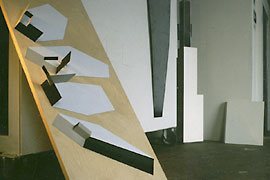
How they appear and how they fold back into their 2-dimensional surface image when viewed from the right angle. If the viewer squints when looking at the pair of pictures in 3-D, the illusion disappears and the actual spatial features become apparent.
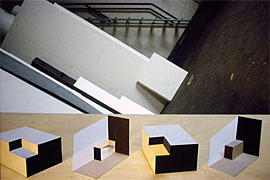
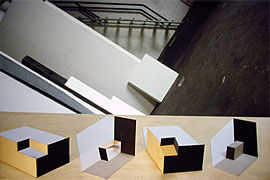
The individual pictures of Spot 23's cube film are two-dimensional. Information about the third dimension is missing. The brain, however, constructs three-dimensional situations from the 2-dimensional figures by means of visual intelligence on the one hand and acquired knowledge on the other.
If the viewer squints, the following four pairs of pictures result in a relatively unambiguous spatial picture, thanks to the additional stereoscopic information. Instructions on «squinting» can be found in Spot 11.
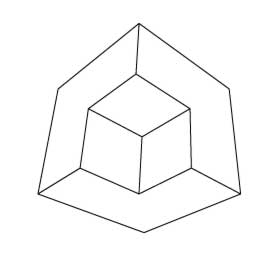
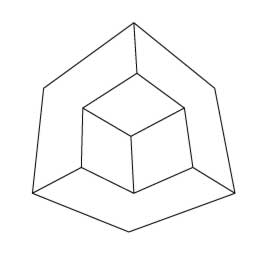
1. A large cube with a small cubic cut-out section in the front corner
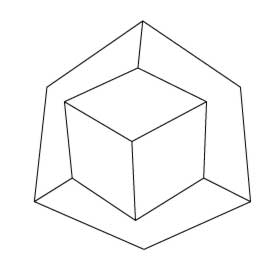
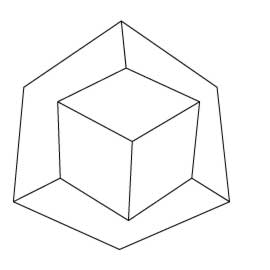
2. A large cube with another cube in the forefront turning in the opposite direction
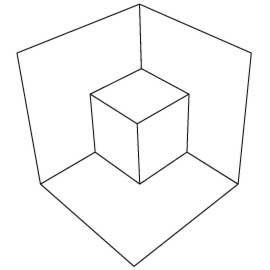
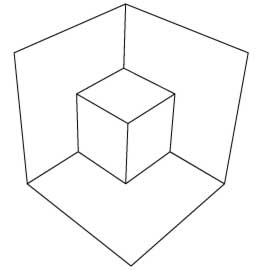
3. The corner of a room with floor, 2 walls and a cube stuck in the corner
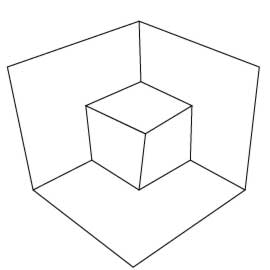
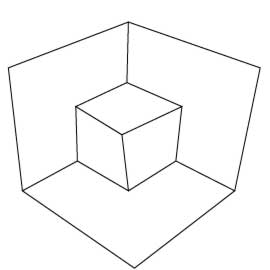
4. Section of the corner of a room with a deep pyramid- shaped hole
The first three interpretations can be seen relatively easily by most people. However, the fourth requires experience of pictures of spatially distorted images. Switching between the four interpretations demands mental effort. It is possible that a newly-discovered spatial image remains stable for several minutes and it is only through the viewer's power of imagination that it is transformed into another spatial image, which then again remains stable for some time.
Be patient, first try to relax and practise speeding up switching between the spatial images.
There are in fact, an infinite number of spatial images that are compatible with the 2-dimensional models in the cube film. It is interesting to note that our brain, in accordance with the laws of Gestalt, subconsciously always prefers meaningful situations and objects. As a rule, these are simply-constructed right-angled configurations and objects. In the last century, the Gestalt psychologists were especially interested in the inventory of objects that were stored in the brain together with their level of significance. With a great effort of the imagination, even single «squint» images can be influenced and, despite supplementary stereoscopic information, can be transformed into other images. This blelb discovery indicates that the stereo images in our brain are not only composed purely passively from the available spatial information, but that active top-down processes are also in play, with perceptions that can even contradict the image information. The cube-shaped empty spaces in the first squint picture can also be seen as a cube in the foreground.
Seeing a picture means composing an image in the brain.